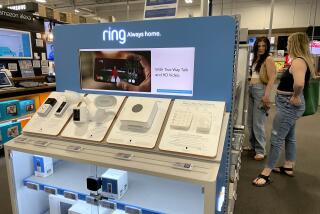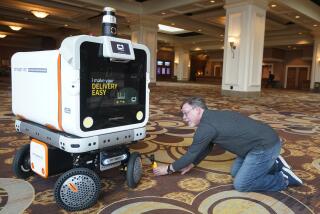Get Out Your Plastic
- Share via
You don’t need Bill Gates’ vision to create a smart house, but it wouldn’t hurt to have his wallet. And the patience of Job. Many of the core features of the Microsoft Home--the cleverly automated lights and blinds, the links between computers and TV screens--already are on the market in some form, and others are on the way. What’s missing today is an easy way to set up and use them.
Out now
* Door locks that open with the touch of your (unique) hand. Among those that respond to fingerprints instead of keys is the Shepherd 220 from ArrowVision Technologies, which costs about $500.
* Picture frames that pull images from the Internet. The Ceiva Digital Photo Receiver ($150 list, plus $100 per year in service charges) uses a standard phone line to dial into the Net every night and download up to 30 images.
* Lights, appliances, blinds, thermostats and sprinklers that can be controlled with your cellphone. An array of manufacturers make the widgets needed to link basic home electronic devices into a programmable network. HomeSeer Technologies adds an interface for about $150 that allows the network to be controlled via the Internet. For an additional $25, the HomeSeer software can be accessed through a Web-enabled cellphone.
* Music to match your mood. Using the music stored on your computer, MoodLogic (about $40) generates playlists in six different moods and a range of tempos. Those tracks can then be piped through a home network and played on a stereo, either through a wireless receiver such as the Roku SoundBridge M500 ($199 list) or a TiVo digital video recorder.
* A microwave oven that knows how to cook. The Beyond Microwave Oven ($257 list, about $180 in stores) combines a Westinghouse microwave with a wand that scans the bar codes on food packages. If the oven recognizes the bar code, it will automatically set itself.
Out soon
* Cars that download new songs and videos when you pull into the garage. Omnifi already offers an add-on hard drive for a car stereo that can download music wirelessly from a home network for about $350. The next version is expected to cost twice as much, but will be able to store digital movies as well as tunes.
* Television sets that can tune in photos, movies, TV shows, games and music stored on any other device connected to the home network. In October, Sony and Toshiba were among the companies demonstrating such sets and tuners. The main missing piece at this point is the ability to transfer rented movies and DVDs.
* Ovens that can be programmed remotely through the Internet. Whirlpool’s initial version of the Polara is a hybrid refrigerator/oven--it can be programmed to keep raw food cold for several hours before it begins cooking, so you can leave for a day at the office and come back to a hot supper. The company experimented in 2004 with an even smarter version, though, that allowed cooking times to be adjusted remotely via computer or Internet-enabled cellphone.
* Smart shopping carts. Boston-based supermarket chain Stop & Shop is deploying carts that tap wirelessly into store records and connect to overhead sensors. The carts read data from Stop & Shop’s discount cards to learn customers’ buying habits, and the sensors tell them what products are nearby at any moment. The carts then alert the shoppers to special offers that are likely to appeal to them. Eventually, shoppers will be able to e-mail grocery lists to the store and have the data loaded into their carts.
Way out
* Walls and counters that double as digital displays. The Microsoft Home uses Organic Light-Emitting Diode technology to incorporate video screens into walls and other surfaces, but that approach is so expensive today, some experts believe a more likely alternative is a lightweight electronic tablet that one can carry from room to room, connecting wirelessly to the home network.
* A printer that spits out 3-D objects. Manufacturers rely on the industrial version of these devices to create models of their products out of colored resins. The shrinking size and price of these printers lead some to believe that they may find their way into homes--imagine being able to print a replacement for a broken handle on your refrigerator. But with an entry-level price of about $25,000, that day remains a long way off.
* Kitchen utensils that help you cook well. The Massachusetts Institute of Technology has developed a prototype of a mixing spoon with a sense of taste and touch. It can tell you, for example, when you’ve added too much salt. There’s no indication, though, if or when the idea will make its way onto store shelves.







